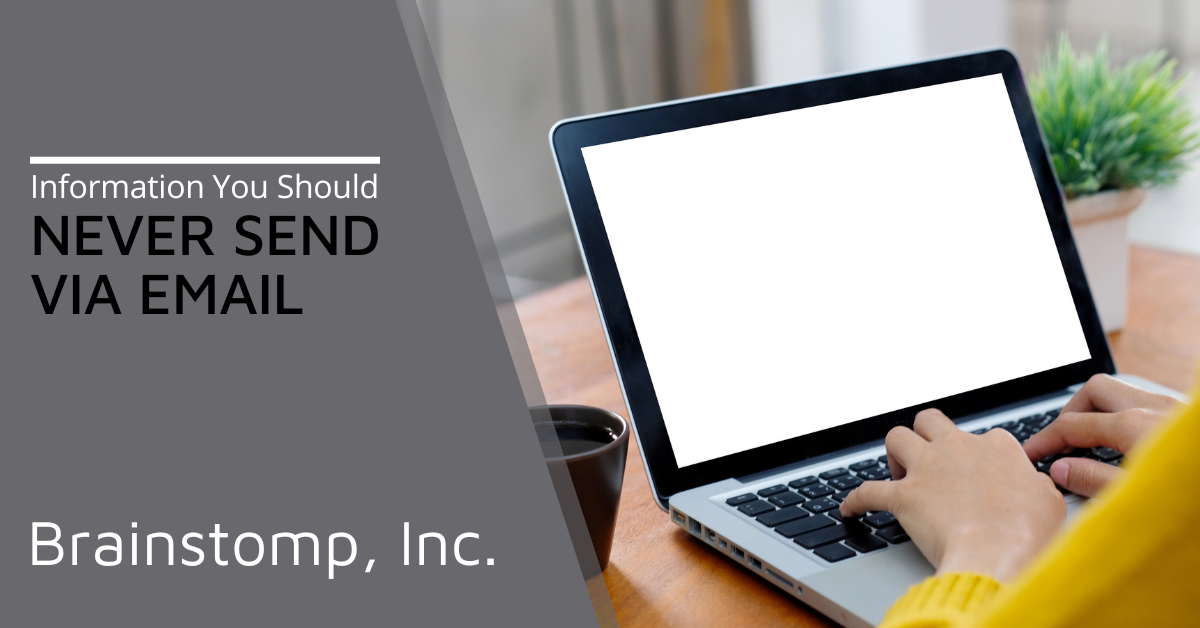Information You Should Never Send Via Email
/You’d never hand your house keys to a stranger—so why send your password in an email?
Emails are an essential part of your everyday workflow. They’re fast, easy, and reliable. But here’s the problem: not everything belongs in an email.
Some things, like passwords or financial info, should never be sent over email. One wrong click can lead to major damage. At a time when cyber threats are more advanced than ever, keeping sensitive information safe isn’t just about good habits—it’s about having smart IT solutions in place to back you up.
Rushed Emails, Risky Mistakes, and How to Stay Protected
We’ve all done it. Your day is hectic, and you are in a rush trying to complete your tasks, and suddenly someone asks you to email your logins to them. This feels harmless, but things can take a turn anytime.
Too many businesses learn the hard way that email is not secure by default. And if you’re sending sensitive details without a second thought, you’re giving cybercriminals an open door.
Good news? You don’t need to make drastic changes to your entire system—just stay aware and set up the right systems to keep your data safe.
What Not to Send Over Email and Why
1. Passwords and Login Credentials
Let’s start with the biggest point: never send your passwords over email — not to coworkers, not even for "just this once." If your email gets compromised, that message becomes a treasure map for hackers. And even if you delete the email, there’s no guarantee the other person will.
2. Credit Card Numbers or Payment Info
This is another major no-go. Emailing your credit card info is risky, like leaving your wallet out in public and hoping no one picks it up. Even if your email provider uses encryption, the receiver's system might not.
3. Financial information
Things like your financial information should never be sent via email, even if it is your own bank asking you to email them. The reason is that your email can be intercepted, and all the information in it can be used illegally for fraud and other crimes. Make sure you are using secure portals and encrypted messaging instead.
4. Social Security Numbers
Your Social Security number unlocks everything—if stolen, it can be used to open accounts, steal credit, or file fake taxes. It should never travel through regular email.
5. Attorney-Client Privileged Documents
Legal documents need extra protection. Emailing them—especially without encryption—can put confidentiality at risk. Always use a secure file-sharing platform to keep things private and compliant.
6. Health Records or Medical Info
Health info is personal and should be kept private. Sending it through email isn’t safe and could put people at risk.
7. Driver’s License Numbers
A stolen driver’s license number can be used for a range of fraudulent activity—from fake identity creation to benefit fraud. Avoid sending copies or numbers of these IDs through email.
8. Passport Numbers
Your passport number is also very personal and powerful. It can be used in identity theft schemes or sold on the dark web. Keep it off email entirely.
9. Business Tax IDs or EINs
Your EIN might not feel sensitive, but if someone gets it, they can pretend to be your business and open fake accounts. Treat it like your personal ID—keep it safe.
One Email Can Open the Door
The scariest part? Most breaches start with something small. One employee shares a password over email. One manager sends bank details without encryption. It doesn’t take long before hackers find their way in.
Once inside, attackers can carry out the following.
Steal funds
Lock down your systems with ransomware
Leak client data
Damage your reputation beyond repair
And just like that, a business you spent years building could be turned upside down—all because of one unguarded email.
How to Stay Protected
Here’s how to make email safer without giving up convenience:
1. Use a Password Manager
Make sure you are not storing your passwords in your inbox or spreadsheets. You can, however, use password managers that keep everything secure and even make sharing information safe.
2. Add Multi-Factor Authentication
In case of a stolen password, MFA adds one extra step for the attacker, which usually makes them give up and move on rather than struggle to retrieve the code or device confirmation.
3. Encrypt Sensitive Messages
In cases where sharing is necessary, make sure you are only doing it through encrypted email tools or safe sharing platforms.
4. Train Your Team
Most breaches are a result of human error. Make sure your employees are trained and aware of what can and cannot be shared via email. But if their task requires sharing info, make sure you provide them with the necessary tools and support.
5. Get the Right IT Solutions in Place
Your team needs backup—partner with IT experts to secure email, block threats, and protect your systems.
Email Should Help Your Business, Not Hurt It
Email makes business easier—but it can also open the door to serious threats if you’re not careful. One wrong click or shared password is all it takes.
That’s where Brainstomp comes in. We help secure your inbox, train your team, and put the right protections in place—so you can focus on your business, not chasing down problems.
Let Brainstomp handle your email security—because one smart move today can prevent a major headache tomorrow.

